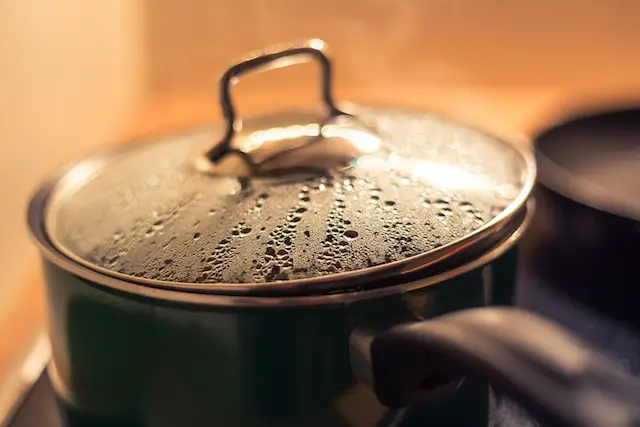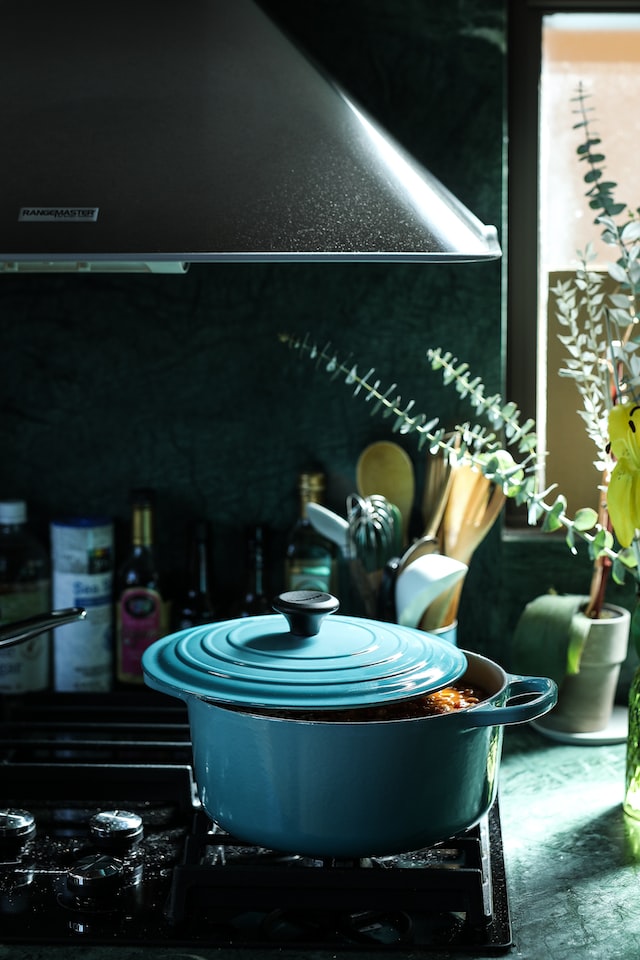Boiling uses hot water to cook food. Steaming uses hot steam to cook food.
What is boiling?
(Photo by Uwe Conrad on Unsplash )

Boiling is the process by which a liquid is heated to its boiling point and converts into a vapor or gas. This occurs when the temperature of the liquid reaches a point where its vapor pressure is equal to the pressure of the surrounding atmosphere. The boiling point of a liquid depends on factors such as pressure and the composition of the liquid. When a liquid boils, its molecules become more energetic and break free from the surface, forming bubbles. Boiling is commonly used in cooking to heat and cook food, and also as a means of sterilizing water and other liquids.
What is steaming?
(Photo by Thom Milkovic on Unsplash )

Steaming is a cooking method that involves cooking food with steam, typically by placing the food in a steamer basket or a perforated tray over a pot of boiling water. As the water boils, steam is generated, and the food is cooked by the heat and moisture of the steam. Steaming is a healthier cooking method compared to others, as it doesn’t require oil or fat to cook the food and preserves its nutrients and flavor. Steaming is commonly used to cook vegetables, fish, and other delicate foods, and is also used in industrial applications for sterilization and cleaning. Additionally, it is a popular technique for facial treatments, as it can help to unclog pores and hydrate the skin.
Steamed Vs. Boiled – Key differences
The key difference between steaming and boiling is the way in which food is cooked. Boiling involves immersing food in boiling water, while steaming involves cooking food with steam. Boiling requires a lot of water and can lead to loss of nutrients and flavor, while steaming requires little or no water and helps to retain the nutrients and flavor of the food. Steaming is also a healthier cooking method, as it doesn’t require oil or fat, while boiling can require the addition of oil or salt to enhance the flavor. Steaming is ideal for cooking delicate foods like fish and vegetables, while boiling is better suited for tougher foods like potatoes and pasta. Ultimately, the choice between steaming and boiling will depend on the food being cooked and personal preference.
Which is better steamed food or boiled food?
Both steaming and boiling can be healthy cooking methods, as they allow for cooking food without added fats or oils. However, in general, steaming may be considered a healthier option as it preserves the nutrients and flavor of the food better than boiling. This is because steaming uses less water, which means that fewer water-soluble vitamins and minerals are lost during the cooking process. Additionally, since steaming does not require the food to be submerged in water, it may be less likely to be overcooked or become waterlogged, which can affect the texture and taste of the food. Ultimately, the best cooking method will depend on the food being cooked and individual preferences.
Which vegetables should not be steamed?
Most vegetables can be steamed with great results, but there are a few exceptions. Vegetables with a high water content like zucchini, cucumber, and tomatoes are better suited to being grilled or sautéed, as they may become too soft when steamed. Additionally, some cruciferous vegetables like Brussels sprouts and cauliflower can release a strong odor when steamed, which may not be appealing to some people. However, this can be mitigated by adding aromatics like garlic or herbs to the steaming water. Overall, it’s important to consider the texture and flavor of the vegetables when deciding whether to steam them or use another cooking method.
What are the advantage of steaming and boiling food?
The advantages of steaming and boiling food include:
- Healthier cooking method: Both steaming and boiling are healthier cooking methods as they don’t require added fats or oils, which can contribute to unhealthy diets.
- Retains nutrients: Steaming and boiling can help to retain the nutrients and flavor of the food, especially when compared to other cooking methods like frying or baking.
- Versatile: Steaming and boiling are versatile cooking methods that can be used for a wide range of foods, including vegetables, meats, and grains.
- Easy to do: Both steaming and boiling are easy cooking methods that don’t require a lot of equipment or special skills.
- Affordable: Steaming and boiling are affordable cooking methods that don’t require expensive equipment or ingredients.
- Can be used for large quantities: Steaming and boiling can be used to cook large quantities of food at once, making them ideal for meal prep or feeding a crowd.
Steaming and boiling are simple, healthy, and versatile cooking methods that can be used to prepare a wide range of nutritious and delicious meals.
Is it better to steam or boil chicken?
Both steaming and boiling chicken are healthy cooking methods, but they may produce different results in terms of texture and flavor. Steaming chicken can help to retain its natural juices and flavor, while boiling can result in a slightly softer texture. However, boiling can also be a quicker cooking method, especially if the chicken is cut into smaller pieces. Ultimately, the best cooking method for chicken will depend on personal preference and the recipe being used. For example, steamed chicken may be more suitable for dishes that require a firmer texture, like stir-fries, while boiled chicken may be better for soups or stews where a softer texture is desired. It’s important to ensure that chicken is cooked to the appropriate internal temperature (165°F or 75°C) regardless of the cooking method used.
What is the difference between steaming and boiling rice?
The main difference between steaming and boiling rice is in the amount of water used and the method of cooking.
Boiling rice involves using a lot of water and cooking the rice in it until it becomes tender. Once the rice is cooked, the excess water is drained off, and the rice is ready to serve.
Steaming rice, on the other hand, involves using a specific amount of water and a separate vessel for cooking the rice. The rice is first rinsed and then added to a pot with the appropriate amount of water. The pot is then covered with a tight-fitting lid, and the rice is cooked using the steam generated by the boiling water. Once the rice is fully cooked, the pot is removed from the heat and allowed to sit for a few minutes before being fluffed with a fork.
The result of steaming rice is often fluffier and more separated grains, while boiled rice may be stickier and clumpier. Additionally, steaming rice can be a healthier option, as it can help to retain more of the rice’s natural nutrients and flavor.
Photo by Edgar Castrejon on Unsplash








